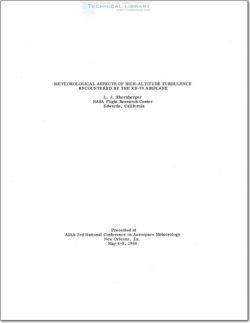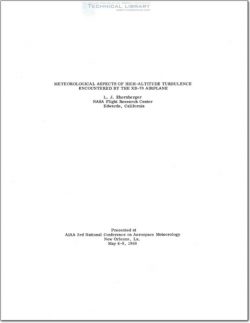NASA-XB-70

- Version
- 146 Downloads
- 539.69 KB File Size
- 1 File Count
- June 16, 2016 Create Date
- June 16, 2016 Last Updated
Meteorological Aspects of High Altitude Turbulence Encountered by the XB-70 Airplane

As a result of the supersonic transport (SST) aircraft development program, there is an increased need for
information on high—altitude atmospheric turbulence and ambient—temperature transients. Little data exist on these
atmospheric features for altitudes between 40, 000 feet (12, 200 meters) and 80,000 feet (24, 400 meters), the
interval within which the SST is expected to climb and cruise at supersonic speeds. Although highealtitude—
turbulence information in the form of derived—gust—velocity statistics has been obtained over a period of several
years during routine operational missions of the U—2 airplane (refs. 1 and 2), data on the associated meteorological
conditions have not been available until recently (refs. 3 and 4). An additional source of these data has been pro—
vided by turbulence and temperature transients encountered during test flights of the XB—70 airplane, which is
similar in configuration and performance to the proposed SST. A preliminary evaluation of the XB—70 airplane
response in turbulence is given in reference 5.
This paper discusses the preliminary results of a study of meteorological features associated with turbulence
encountered by the XB—70 airplane at flight levels above 40, 000 feet (12,200 meters). Also, three of the larger
temperature transients encountered during level flight at high altitudes are described. This study was conducted at
the NASA Flight Research Center, Edwards, California, and covers DUB—70 airplane flights made between April 1965
and March 1966 over the Western United States.
Instrumentation used in the XB—70 airplane flight—test program furnished measurements of the airplane center—
of~gravity normal acceleration, altitude, airspeed, total temperature, location, time of day, and rawinsonde
observations of the upper—air winds and temperatures. The XB-70 flight tests were conducted over the Western
United States, as shown by the shaded area in figure 1. Within this area, ground—based tracking radar were used
to determine the airplane location. The stations from which rawinsonde observations were available for this area
are also shown in the figure.
An NASA VGH recorder (ref. 6) carried in the XB—70 airplane provides time ehistory traces for the values of
airspeed, normal acceleration at the airplane center of gravity, and pressure altitude. When the airplane was
flying through turbulence, rapid fluctuations appeared on the normal—acceleration trace and irregular disturbances
could be noted on the airspeed trace, as shown in figure 2.
| File | Action |
|---|---|
| NASA-XB-70 Meteorological Aspects of High Altitude Turbulence Encountered by the XB-70 Airplane.pdf | Download |
Comment On This Post